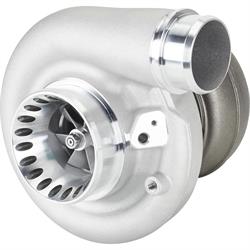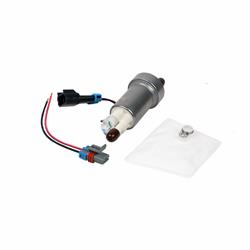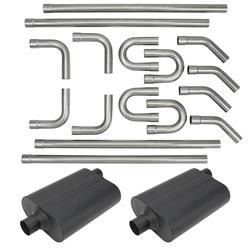LS Turbo Setups: Twin vs Single (with Sizing Guide)
More horsepower, less cost: Discover the game-changing potential of turbo LS engines, most notably the 4.8, 5.3, and 6.0 truck-based engines can deliver a dollar-to-horsepower ratio that's hard to match using any other engine. So, if you're ready to start making those power dreams a reality, keep reading.
Which is the Best LS to Turbocharge?
No matter the size, all LS-based engines respond favorably to boost. In fact, even a turbo 4.8 or turbo 5.3 Vortec engine can reach power levels like those of a turbo 6.0 LS. Sure, they might need a bit more boost, but don't count them out if they're what you've got on hand.
But which LS engine is the best to turbocharge? Let's dive in.
In terms of availability and affordability, the spotlight is on the truck-based LS engines, specifically the 4.8, 5.3, and 6.0. Don't worry if you've got something else in mind. Turbo LS1, turbo LS2, as well as LS3, LS6, LS7, and LSX engines all pack a punch. It's hard to go wrong with any of these options. So, whether you're eyeing a salvage yard pull-out or building a turbo LS3 with a new crate engine, rest assured, these engines can handle serious power.
Twin Turbo vs Single Turbo LS
The single vs. twin turbo debate isn't new, but it's as relevant as ever. Each setup boasts its own advantages and drawbacks, and the best choice hinges largely on your unique needs and goals.
Single Turbo LS:
Pros:
- Simplicity: More straightforward installation. Less modification.
- Cost-Effective: Less parts required and less labor to install.
- Creature comforts: Easier to retain factory A/C and power steering.
Cons:
- Power Distribution: In some cases, LS single turbo setups may not spool as quickly as a twin turbo setup. This is mostly attributed to turbo sizing.
Twin Turbo LS:
Pros:
- Responsiveness: Two smaller turbos spool faster than a big single turbo. This also usually results in a smoother power curve than a single LS turbo setup.
- Peak Power: LS twin turbo can give you all the top end power, without sacrificing low-end response.
- Aesthetics: It’s hard not to appreciate how good a twin turbo LS1 looks in a classic.
Cons:
- Cost: LS Twin turbo builds are more expensive.
- Complexity: More piping. More turbos. More fabrication.
- Creature comforts: Retaining factory accessories is harder with twin turbos taking up engine bay real estate.
Budget LS Turbo Build Considerations
Turboing a 5.3 or any other LS motor isn't just about power; it's about the balance between performance and cost that makes an LS with turbo so appealing. But, when it comes to building a turbo LS on a limited budget, it can be a bit like going grocery shopping when you're hungry. You've got to prioritize what you really need, or you might end up with a shopping cart full of turbos and no cash left for the essential supporting modifications.
Here are a few areas where you can significantly cut costs without sacrificing much on performance or quality:
Cast turbos: Selecting a turbo with a cast compressor wheel will save you a minimum of a few hundred dollars. The downside? Cast turbos won’t spool as fast as an equivalent billet turbo or make as much power. But we’re still talking about a potent turbo that can put down 700 horsepower to the wheels.
Journal bearing turbos: You’ll save another few hundred dollars by going with a journal bearing turbo. Sure, ball bearing turbos offer improved response, and more durability under extreme conditions but the amount of money you can save with a journal bearing turbo is huge.
Speedway Motors offers several LS turbo kit options that eliminate the guesswork from turbocharging your LS without breaking the bank. Our LS hot side kits provide a solid foundation for LS single turbo setups with crossover piping accommodations for 4L60/4L80, T56/6L80, and TH350/TH400 transmissions, or as a universal builder kit.
From there, we have all the parts to finish out your LS turbo build, such as injectors, fuel pumps, turbo flanges, intercoolers and intercooler piping.
Stock LS Turbo HP Goals
Defining a specific horsepower goal early on is crucial as it will dictate the parts you choose and the overall configuration of your build. This decision will shape the direction of your project and ultimately determine the level of performance and satisfaction you'll derive from your LS turbo project.
While aiming for the highest possible power output is tempting, it's important to remember, finding a happy medium between your horsepower goals and responsiveness is the key to enjoying your turbo setup.
How Much Boost Can a Stock LS Handle
We get this question often, but the reality is stock LS engines have been known to handle extreme boost levels. Although, boost pressure isn’t an engine parameter that we look at independently. Finding that perfect balance between air/fuel ratio, timing advance, and boost pressure across the RPM range is critical for performance, drivability, and the longevity of your turbo LS build. We recommend seeking the help of an experienced ECU calibrator/dyno tuner to ensure these parameters are properly dialed in.
Other factors that will affect how much boost you can run:
- Type of fuel and fuel volume – Running an ethanol-based fuel like E85 lets you safely increase boost and advance timing well beyond the limits of pump gas, resulting in more power.
- Water/methanol injection - If E85 isn’t available in your area water/methanol is a good alternative that will let you turn up the boost.
- Intercooler – How effectively you can cool your charge air temps will dictate how much boost you can run and how much power you make.
- Turbo size – With an undersized turbo, increasing boost won’t increase power due to excessive backpressure. If your turbo is too big, you’ll run into issues with turbo lag and have a hard time hitting peak boost.
- Wastegate configuration – Wastegate spring pressure and the positioning of the wastegate.
Best Turbo Size for LS engines
Remember, this is a simplified approach. There is no one-size-fits-all LS turbo size. These recommendations can be used as a starting point for most street/strip LS turbo builds.
Best turbo for 4.8 LS:
- One of the best options for 4.8 LS single turbo builds is the 7875 Billet Turbo .96 A/R. LS 4.8 turbo applications can spool this turbo reasonably quickly and supports up to 800-wheel horsepower, provided you've got the basic supporting modifications in place, like a cam, springs, converter, and injectors. If you’re planning for the top end of that range, consider the 7875 Billet Turbo 1.25 A/R for up to 900 HP at the wheels.
- For a twin turbo 4.8 LS setup, a pair of mirrored 6762s in normal and reverse rotation, or twin 6673 turbos are the top choices. The 6762s spool instantly. However, twin 6673s can support up to 1,200whp and still spool quickly.
Best turbo for 5.3 LS:
- For a 5.3 LS Turbo build, the 7875 Billet Turbo 1.25 A/R is your go-to. It will spool reasonably fast in a 5.3 single turbo build and support up to 900-wheel horsepower, provided you've got the basic supporting modifications in place, like a cam, springs, converter, and injectors. If you already have a 5.3, and you’re ready to unlock its full potential, check out our 5.3 LS build recipes and LM7 turbo kit options.
- For twin turbo 5.3 LS applications, a pair of mirrored 6762s in normal and reverse rotation, or twin 6673 turbos are the best options. The 6762s spool instantly. However, twin 6673s turbos can support up to 1,200whp and still spool quickly.
Best turbo for 6.0 LS:
- The go-to single turbo for a 6.0 Vortec turbo build is the 7875 Billet Turbo 1.25 A/R. A turbo 6.0 LS will spool this turbo quick and support up to 900 horsepower at the wheels, provided you've got the basic supporting modifications in place, like a cam, springs, converter, and injectors. Speedway Motors offers LQ4 turbo kit options too, if you’re looking for the best quality, with competitive pricing.
- For 6.0 LS twin turbo applications, a pair of mirrored 6762s in normal and reverse rotation, or twin 6673 turbos are the best options. The 6762s spool instantly. However, twin 6673s turbos can support up to 1,200whp and still spool quickly.
To accurately match the perfect turbo to your unique application, several other factors, like vehicle weight, intended use, turbo efficiency, turbine size, and compressor map matching, should be considered. Consulting with experienced turbo LS ECU calibrators, turbo manufacturers, or utilizing advanced turbo sizing tools can provide results tailored to your specific engine setup and goals.
How to Build a Turbo LS Engine
Before you start welding together that turbo setup, take the time to understand how the different components work together and the role they each play in your build. Know your budget, your power goals, and how you plan to use your LS motor turbo build. Understanding these things will not only help you make the right choices, but it will also save you from spending money on things you don't need.
Let's go over the basics of performance engine preparation for boost.
- Injectors and Fuel Pump: Your fuel system requirements will vary depending on whether you’re running EFI or a blow through carb, how much power you want to make, and what type of fuel you’re running. A 450 liter-per-hour fuel pump is usually a good starting point. This will support 800HP with EFI or 950HP with a blow-through carb on pump gas. E85 is a much better fuel for turbo setups and will allow you to safely run more boost and timing advance, but it will require more fuel volume than pump gas. The same 450 LPH pump supports 550HP EFI or 700HP with a blow-through E85 Carburetor, so you may need an additional fuel pump or a bigger fuel pump to run E85.
- Exhaust: Free flowing exhaust is key for turbo response and efficiency. This includes turbo manifolds or turbo headers, a cross-over and a minimum of 3” exhaust piping.
- Wastegates: Wastegates are responsible for controlling boost pressure. Inconsistent boost pressure makes tuning difficult and can result in engine damage. Our advice: take the money you saved by going with a budget turbo and spend it on a good wastegate like this 50mm.
- Intercooler: Cooling the compressed charge air before it enters the engine is one of the easiest ways to consistently make more power.
- Engine Management: Custom ECU calibrations (dyno tunes) are a superior option compared to generic OTS (Off-The-Shelf) maps and can even improve a completely stock LS. Although, finding a pro tuner experienced with turbo LS builds may not be possible in some locations. For those situations, we have options like FiTech 70051 LS Standalone EFI ECU.
LS Ring Gap for Boost
It’s highly recommended to open your piston ring gap when boosting your LS engine. Rings expand when heated, and with the extra heat produced as a byproduct of turbocharging, they need extra room to expand. Skip this step, and your chances of experiencing a piston failure increase substantially.
Factory LS Piston Ring Gap Recommendations for Turbo Applications
Choosing the right parts for your turbo LS swap can seem overwhelming, but don't worry, we're just a phone call away. Whether you’re just getting started and have basic questions or need help selecting the best parts for a complete Foxbody LS turbo kit. Give us a ring and let us partner in your passion today.
So, what are you waiting for? Turbocharge that LS engine! Enjoy the thrill of power, that sweet turbo noise, and the pride that comes from doing it yourself. You'll find it's a journey worth taking. Explore our range of LS turbo kits and turbo components today.















